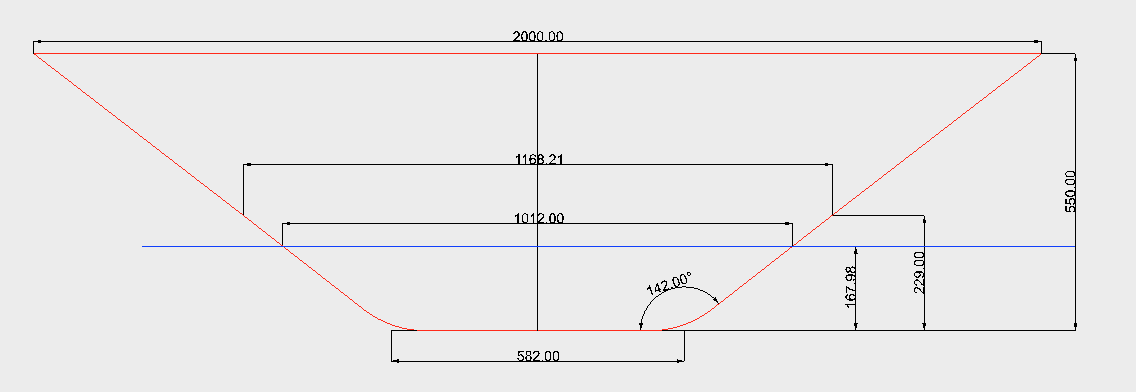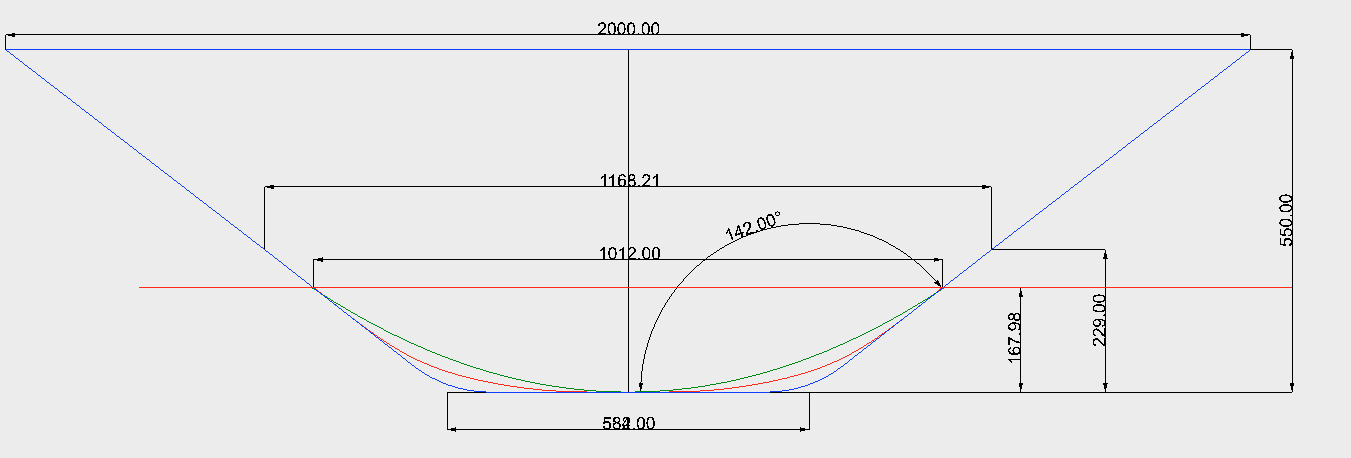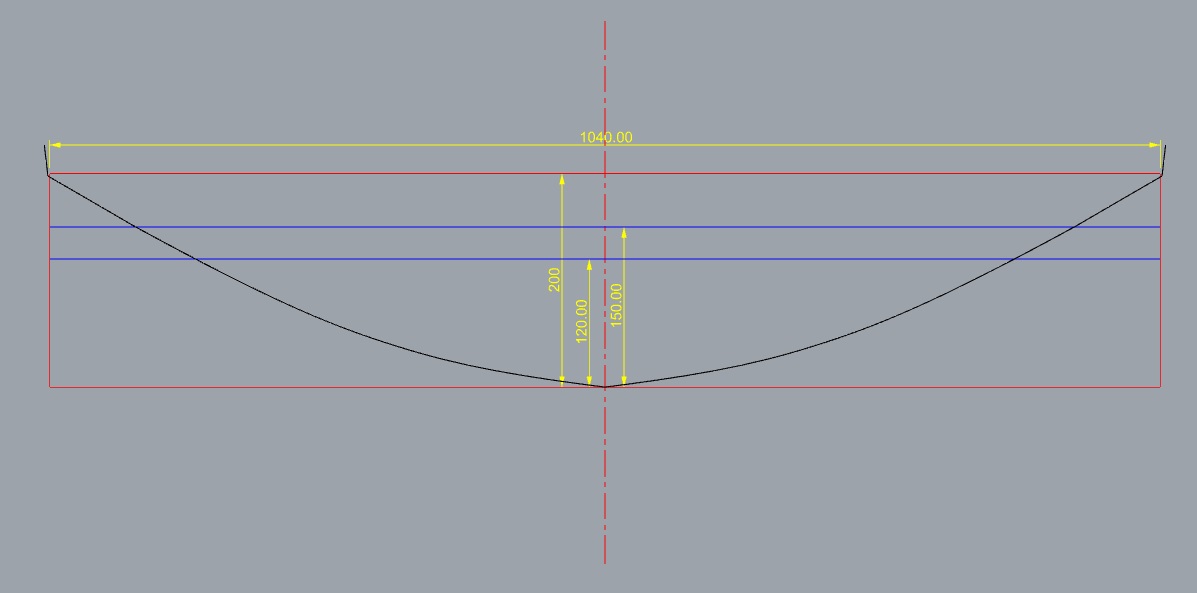What does this measurement rule mean?
Printed From: Yachts and Yachting Online
Category: Dinghy classes
Forum Name: Dinghy development
Forum Discription: The latest moves in the dinghy market
URL: http://www.yachtsandyachting.com/forum/forum_posts.asp?TID=13240
Printed Date: 17 Aug 25 at 7:24pm
Software Version: Web Wiz Forums 9.665y - http://www.webwizforums.com
Topic: What does this measurement rule mean?
Posted By: Guests
Subject: What does this measurement rule mean?
Date Posted: 03 Jan 19 at 10:28pm
|
From the N12 class rules:
4.3.3 At midlength, measured 229mm above the lowest points on the outer surface of the skin (or on a straight line, bridging any hollows, parallel with the vertical plane through the fore and aft centreline) between 40mm and 150mm from the fore and aft centreline of the hull at midlength, shall not be less than 1168mm. This measurement shall be taken to the straight line bridging adjacent lands if any. Iím really struggling to understand what this means  . Halfway between the bow and the stern, 229mm above the keel band the beam should be no less than 1168mm? What is the 40-150mm thing, and how do you measure a point 229mm above the bottom? . Halfway between the bow and the stern, 229mm above the keel band the beam should be no less than 1168mm? What is the 40-150mm thing, and how do you measure a point 229mm above the bottom?
|
Replies:
Posted By: Sam.Spoons
Date Posted: 03 Jan 19 at 10:32pm
|
You need a measurement form, or a set of plans to decipher this. Or just phone up the class measurer and ask him? ------------- Spice 346 "Flat Broke" Blaze 671 "supersonic soap dish" |
Posted By: zippyRN
Date Posted: 04 Jan 19 at 1:47am
is this the rule that lead to 'Baggy bumps ' on nationals ? |
Posted By: JimC
Date Posted: 04 Jan 19 at 6:59am
Its usually best to take these rules in stages, and you can then remove the bits that are to do with loopholes and weird shaped boats and understand the meat.
OK, so its a rise of floor rule. Most box rule classes have them. The idea is to prevent the boat being too skinny at a point that vaguely approximates to waterline beam.
This is 'weird shaped hull' stuff, given a normal boat you can ignore it. If the boat has a normal convex rockerline and no concavities n the outer surface it won't come into play.
So this will be the actual beam restriction. They have either worded it IMHO clumsily or else appear to have stuffed the proof reading and left a word or two out! The usual way of checking these measurements is to make a jig consisting of a piece of wood 1168mm wide, with a two other pieces sticking down 229mm at each end - a very shallow U shape. If both prongs don't touch the hull then the boat is too thin.
And this is more weird shaped hull stuff - in this case allowing for clinker built hulls. Does that help? |
Posted By: JimC
Date Posted: 04 Jan 19 at 7:21am

This sort of thing for the jig. The red boat would fail as being too skinny, the green one would pass. The boats are of course inverted, as they usually are when doing hull measurement. |
Posted By: Guests
Date Posted: 04 Jan 19 at 8:40am
| Ah, thank you! |
Posted By: davidyacht
Date Posted: 04 Jan 19 at 11:06am
|
"the 40-150mm thing" are a couple of pins on the jig, because earlier 12's had a hog, keel and keelband, whereas 40-150mm measures off the hull skin. We had a 12 that had two slots routed out for the jig pins to sit into in order to get a particularly skinny 12 to measure at the rise of floor points. There also used to be a pan rule to control distortions in way of the rise of floor points. It is common to design a chine in at the risse of floor point such that the pins rest on the outside corner of the chines. The rule is probably a bit messy, because bits have been added to reflect challenges to the rule. Can't wait to see what iGRF makes of this ... ------------- Happily living in the past |
Posted By: giraffe
Date Posted: 04 Jan 19 at 12:41pm
|
Page 21 of the measurement manual will help you.
https://www.national12.org/downloads/MeasuresManual.PDF For info, 1168mm equates to 46 inches; 229mm is 9 inches. Otherwise, the rise of floor rule is a basic type forming rule for a box class rule such as the N12. Boats built tend to be bang on max length, max width and have minimum rise of floor as this will give minimum wetted surface area. Rise of floor can be difficult for a builder and it is not uncommmon to see small measurement bumps - |
Posted By: Guests
Date Posted: 05 Jan 19 at 9:12pm
|
So, possibly interesting finding... or not.
If you assume that a midship area equal to a triangle of width 1168mm and height 229mm (0.134m2) is sufficient to float a N12, then there is an underwater cross section shape that is somewhere between that triangle and a rectangle that minismises the waterline beam. It turns out that the narrowest waterline (just over a metre) is when the base width is exactly half the rule width (so mid way between a triangle and a rectangle) and the sides flared out by 52 degrees. The wetted surface area is also, within a fraction of a percent, at a minimum with this shape too. So it would seem a reasonable starting point to base the midship section of a 12 on this shape (I assumed straight sides and a flat bottom for simplicity but a bit of curvature wouldnít change things much). The geek in me thought it interesting enough to share. 
|
Posted By: JimC
Date Posted: 05 Jan 19 at 10:49pm
|
You're ignoring rocker and waterplane, which make quite a difference to how the wetted area works out.
But yes, rise of floor rules can be rather type forming, doubly so if the measurement is at midlength, which is not where you want the widest part of the boat. The Australian (and pre 1984 UK) Cherub rules are notably influential in that way,leading to some unexpected shapes. When we were drafting the new IC rules a lot of attention was spent in attempting to get a rule that would have the desired effect in mandating the targeted width of boat without forcing the designer down a particular shape. |
Posted By: giraffe
Date Posted: 06 Jan 19 at 8:51am
|
Rise of floor is only type forming to the extent that if you did not have then a different typeform which would be narrower. Some limits need to exist eg length, weight, beam and waterline width, max centreboard projection, rig height, rig area
If only it was so simple as the drawing. As Jim says, rocker, buoyancy distribution, planning sections, interaction with horizontal rudder foil are questions to answer. Why generally do dinghies have u shaped hull sections but speedboats have v shaped sections, Who is correct? |
Posted By: davidyacht
Date Posted: 06 Jan 19 at 9:19am
|
You will achieve the lowest wetted area a given prismatic coefficient by using circular sections, which would give you a slippery boat, the interesting bit with a Twelve is how to incorporate planing sections without compromising the light wind speed offered by low wetted area, in a boat that is basically too short. Traditionally this was done by incorporating chines and flatter sections toward the stern to encourage the hull to break out onto the plane. DCB achieves this by having a slippery hull and transferring the planing surfaces to the rudder foil. Another well travelled route is to go for a high prismatic and force the volume low and into the ends, effectively hanging the middle of the boat between the buoyancy at the bow and stern, this allows the boat to float higher, and reduces the misships waterline beam. ------------- Happily living in the past |
Posted By: Guests
Date Posted: 06 Jan 19 at 10:08am
Yes, I was simplifying to a 2d problem, essentially assuming similar rocker and buoyancy distribution. Given that, the narrowest waterline beam is found as shown. Not saying that is necessarily fastest, but it also happens to be just about lowest wsa as well. |
Posted By: Sam.Spoons
Date Posted: 06 Jan 19 at 10:26am
|
Powerboats do not need good displacement performance and have vee for stability when planing in rougher water (equivalent to dihedral in a planes wings). Flatter sections need less power to get on the plane but are more likely to be upset by rough conditions so the rougher the water conditions the boat is optimised for the deeper the vee.
------------- Spice 346 "Flat Broke" Blaze 671 "supersonic soap dish" |
Posted By: Guests
Date Posted: 06 Jan 19 at 10:37am
Semi circular sections give the lowest wetted area, but circular arcs in general do not. A semi circular section clearly would not fit the rise of floor rule anyway! |
Posted By: JimC
Date Posted: 06 Jan 19 at 10:38am
They both are. Different problems. Sailing dinghies are trying to get the maximum performance from very limited power and operate at a very wide range of speeds, speedboats generally have much more power and focus on high speeds. |
Posted By: Guests
Date Posted: 06 Jan 19 at 11:29am
To be clear, I wasnít suggesting the flat bottom was optimum, merely that that narrowest waterline beam obtainable is around 1m, and that is when you set the bottom width to half the measurement beam. In fact it is the angle of flare that matters, so all the shapes below have the same waterline beam. The sectional area of the simple flat shape is actually too big for a N12, the green line is more like the right area and maintains the narrow beam, with less wetted area.

|
Posted By: davidyacht
Date Posted: 06 Jan 19 at 11:49am
|
The first thing that you need to do is work out your sailing displacement, then your optimum prismatic coefficient ... possibly based on Delft series. This will determine the midship sectional area. This will lie somewhere between the an arc and the section that you have drawn. CAD is your friend. With regard to sailing displacement some thought could be given to whether an allowance needs to be made for the effective displacement reduction due to lift from the rudder foil. ------------- Happily living in the past |
Posted By: Daniel Holman
Date Posted: 06 Jan 19 at 12:28pm
Prismatic is a big deal in wavemaking drag which for a boat like N12 (modal speed 6kts)which is semi displacement mostly (up to 12kts for dinghies) and if I remember delft is only appropriate to yacht forms up to Fn = 0.4 and Cp = 0.58. Not having a kite the 12 can be tuned to that modal speed quite aggresively. That said Optimum prismatic at any given speed is well known and with dinghies you can use trim to have different Cp for different speeds. My prismatic is a whopping 0.75 for upwind displacemembt and trim. I went after a very narrow WL beam in the i14 at upwind condition - in i14 modal speed is probs 10kts but you get a lot more frequency 10 - 16kts so you have to really protect planing performance more than you would in an N12 whilst not losing sight of occasionally going as slow as 5kts. Planing of course you need minimal or zero curvature in transverse or longitudinal planes, and as little deadrise as you can get away with. In my design the deadrise was driven by the chines - one at the measurement point and another aft to act hydrodynamically when planing, but with enough deadrise that they were dry sub 12kts so not inducing drag. All of this done for a matrix of diplacement net of tfoil drag, at appropriate LCG (trim) I'll be honest I don't draw from a midship section but I modelled the Nurbs model to get the pinch there, targeting straight section down from measurement point into waterline. See below for my midship section - you'll find that all things being equal WSA correlates with WL beam and I think these are good things to minimise for displacement and semi displacement work, but may be counter to planing performance, esp early planing performance. Bloody interesting stuff this, spent a looong time pondering it all.
|
Posted By: Daniel Holman
Date Posted: 06 Jan 19 at 12:29pm
I think I get down to 760mm wlb at 120mm draft midships with net disp 190kg, which is quite skinny  |
Posted By: Guests
Date Posted: 06 Jan 19 at 1:50pm
Yes, this is pretty much what I did - all up weight of 220kg (78kg Ďall up weightí + 12kg for what isnít included (sails, boom, rudder etc) + 130kg for the crew. Divide by 3.7m and again by a target Cp of say, 0.6. Gives a midship area of 0.1m^2. Numbers are only rough for illustrative purposes. From there it is possible to derive a narrowest possible rule compliant beam. The N12 rules seem to encourage designing around a midship section and as Dan says thatís not necessarily the right place to start but it makes things relatively simple. Dan - I14 displacement of 190kg? Surely boat plus crew is nearer nearer 250kg or are you allowing for some dynamic lift even at displacement speeds? |
Posted By: Daniel Holman
Date Posted: 06 Jan 19 at 2:00pm
| 190kg = 260 lightship inc crew net 70kg from foil, which you'd get from 9 kts to 12kts boatspeed. |
Posted By: giraffe
Date Posted: 06 Jan 19 at 2:05pm
|
You are right, this is interesting stuff.
Clearly, like the 14, the 12 also has a significant add back from the rudder foil available too. The Jo Richards DCB design is u-shaped whilst the the David Hollom Hijack design has v-shaped sections, which give it good performance in a breeze but with a wetter surface area penalty in lighter stuff |
Posted By: Guests
Date Posted: 06 Jan 19 at 2:11pm
| 70kg wow. Area about 1m x 0.1m? |
Posted By: Daniel Holman
Date Posted: 06 Jan 19 at 2:17pm
| Yep something like that. You operate at pretty much max cl until you have to start dialling it back at >9kts when the bow will start getting driven in too much. |
Posted By: Daniel Holman
Date Posted: 06 Jan 19 at 2:18pm
| 1.2 span maybe |
Posted By: davidyacht
Date Posted: 06 Jan 19 at 3:22pm
|
I went for a CP of .55 with Annie Apple, which was slippery in light winds and ran out chines to the transom for planing performance. Worked pretty well, until my daughter became more adult sized. I drew a foiling rudder for her but never had the courage to see it through. With hindsight I would have gone for a deeper, filled out stem, with less compromise for planing sections, putting more emphasis on the foils for lift. .60 sounds high, but in the 14 sailing in light winds is of less relevance. Ref. Midship section, you need to consider the small tweak of resting the rise of floor jig on the topside chine, and have maximum overhang for the gunwales, also you donít necessarily need to go for minimum freeboard, the geometry of the double floor and the length of your lower leg might push you to a higher freeboard, also this has the effect of reducing the beam of the topsides lower down. ------------- Happily living in the past |
Posted By: craiggo
Date Posted: 06 Jan 19 at 7:57pm
|
It's also worthwhile checking the underwater shapes when heeled to +10į. You don't want to create something which comes to a grinding halt whenever the crew fails to pinch or ease sheet. ------------- OK 2129 RS200 411 |
Posted By: Daniel Holman
Date Posted: 06 Jan 19 at 8:06pm
Nonsense you always design a boat for sailing beyond reproach 😀 |
Posted By: craiggo
Date Posted: 06 Jan 19 at 8:47pm
|
Numerical optimisation is all well and good but you need to be able to keep it in the design groove with MK1 human processing otherwise it won't be very successful. ------------- OK 2129 RS200 411 |
Posted By: Daniel Holman
Date Posted: 06 Jan 19 at 8:57pm
| I realise that all too well with these days pre mk1 Neanderthal processing. I was being facetious / flippant / sarcastic. |
Posted By: Rupert
Date Posted: 06 Jan 19 at 9:16pm
|
Because sarcasm always works on the the internet... ------------- Firefly 2324, Puffin 229, Minisail 3446 Mirror 70686 |
Posted By: Rupert
Date Posted: 06 Jan 19 at 9:18pm
|
Actually, I'm the quest for speed, ease of sailing does appear to be forgotten in many cases, as does a decent light wind performance. Probably one reason dinosaur designs are still popular. ------------- Firefly 2324, Puffin 229, Minisail 3446 Mirror 70686 |
Posted By: zeon
Date Posted: 06 Jan 19 at 9:48pm
Oh wow . Are you the original owner/ designer of Annie Apple ? This boat has been at our club for about the last decade . Itís still going great , in light winds too, with a female crew that is definitely adult sized lol
|
Posted By: craiggo
Date Posted: 06 Jan 19 at 10:32pm
|
Sorry Dan, I did note the sarcasm.
Was just making the point for the benefit of others who might not! ------------- OK 2129 RS200 411 |
Posted By: Daniel Holman
Date Posted: 06 Jan 19 at 11:15pm
| 😀 |